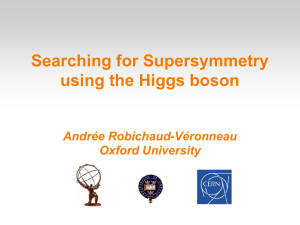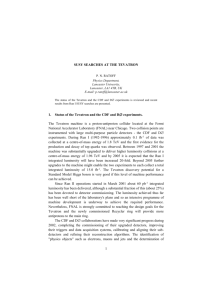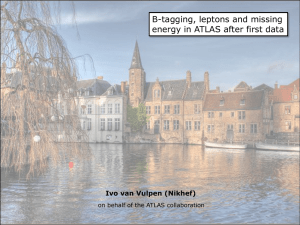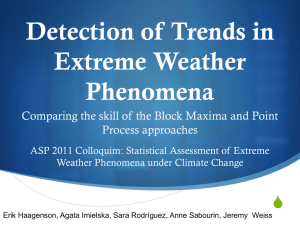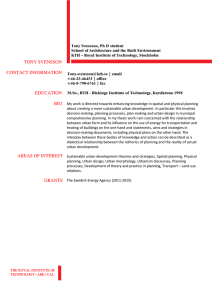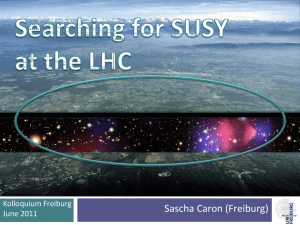Dark matter at LHC
advertisement
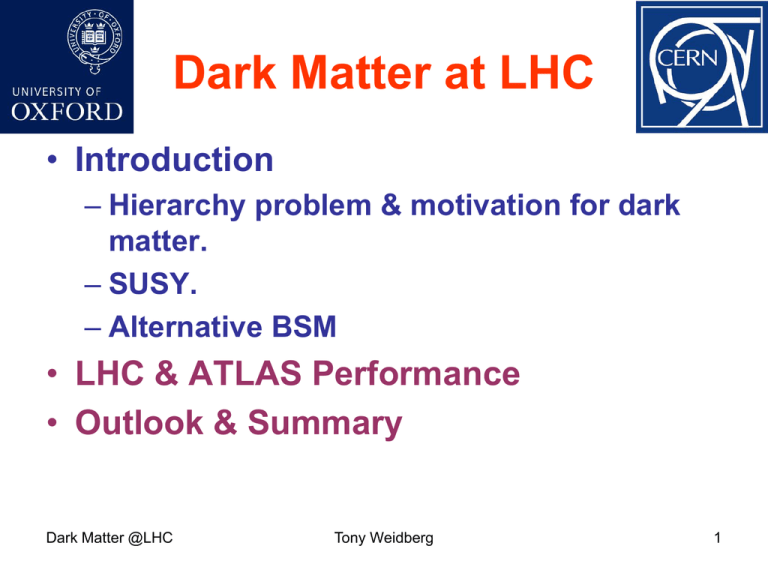
Dark Matter at LHC
• Introduction
– Hierarchy problem & motivation for dark
matter.
– SUSY.
– Alternative BSM
• LHC & ATLAS Performance
• Outlook & Summary
Dark Matter @LHC
Tony Weidberg
1
Introduction
• Hierarchy problem
– Why does the SM Higgs remain light?
– Expect radiative corrections mass to highest
scale in the theory (eg M_planck).
– Requires improbable fine tuning
• Solution requires new physics @ TeV scale.
– eg SUSY
– If we assume R parity conservation LSP is
stable candidate for dark matter.
– Other BSM theories also provide dark matter
candidates
• Eg UED: lightest particle has negative KK parity and
would therefore be stable dark matter candidate.
Dark Matter @ LHC
Tony Weidberg
2
SUSY
• If squarks or gluinos <~ 1 TeV large s high
rates at LHC.
• Cascade decays to LSP.
• Assume R parity LSP stable Missing
transverse energy (MET) in detector
• Very generic SUSY search:
– Multi jets + MET in excess of SM background
• Details are model dependent
3
SUGRA
• Can’t explore 105 dimensional
parameter space of MSSM so need
some unified model.
• Look at SUGRA as an example.
• 5 parameters, m0, m1/2, tanb, A0, sign(m).
• LSP is dark matter candidate but don’t
want too much!
– Restricts regions in parameter space so
that there is efficient annihilation of LSP.
4
SUGRA
• SU1 m0=70 GeV m1/2=350 GeV tanb=10
0
– Coannihilation: 1 l near degenerate
• SU2 m0=3550 GeV m1/2 = 300 GeV tanb=10
0
0
0
– 1 high higgsino 1 1 W W
• SU3 m0=100 GeV m1/2=300 GeV tanb=6
– Bulk: LSP annihilation exchange of sleptons.
• SU4: low mass point close to TeV limits.
• SU6 m0=320 GeV, m1/2=375 GeV tanb=50
0
0
2
m
(
)
m
(
A
) enhances annihilation.
–
1
• SU8.1 m0=210 GeV m1/2=360 GeV tanb=40.
0
– Coannhiliation with m ( ) m ( 1 ) small
• SU9 m0=300 GeV, m1/2=425 GeV tanb=20
– Enhanced Higgs production.
5
Useful Definitions
• MET:
E T ,x
M iss
E T cos( i )
i
i
M iss
ET
{( E T , ) ( E T , y ) }
M iss
2
M iss
2
• Requires good 4p calorimeters + muons
• Infer presence of LSP from large MET
• Can’t reconstruct mass event by event
because of MET is only in transverse plane.
• Define Transverse Mass
mT
( ET ET
a
m iss
) ( pt pt
2
a
m iss
)
2
• For 2 body decays end point at mass of
parent (eg MW).
6
Definitions (2)
M eff
4
E
i
t
ET ET
i
M iss
• Effective Mass
• Meff discriminates between SUSY and SM.
• Peak in Meff gives first crude estimate of
SUSY mass scale.
• More complicated variables required for
mass determinations in events with two
invisible particles eg “stranverse” mass
leptons
jets ,i
7
Backgrounds
• Cosmics, beam halo, beam
gas.
• Fake MET from QCD jets
• Real MET from SM
backgrounds eg
– W -> l n
– t tabr, t b W, Wl n
– Z + jets, Z nn
• Reliable estimates essential
for all backgrounds before
SUSY discovery can be
claimed!
Time difference between
scintillators on two sides ATLAS
8
SM Backgrounds
Background is cocktail of
different SM processes
S/B high at large Meff but
still need data driven
estimates.
9
QCD Background (1)
• Need data driven approach.
• Use pT balance in photon jet
events
– Photon well measured
resolution due to jets.
– Gaussian fits give s vs pt
s (E )
E
A
E
B
Resolutions vs photon pT
C
E
10
QCD Background (2)
• Estimate nonGaussian tails from 3
jet events
– Badly measured jet
direction close to
MET
• Combine Gaussian &
non-Gaussian tails
Jet Transfer Function
(JTF)
• Estimate QCD
background from data
& JTF
11
W & ttbar Backgrounds
• Use MT<100 GeV to define control region
W/ttabr
SUSY
Count events in control region predict SM background in signal region
More sophisticated variations to allow for signal contamination of control
region.
12
No Lepton Mode
Background is cocktail
of different SM
processes
Z nn irreducible
W/top from lost leptons
S/B high at large Meff but
still need data driven
estimates.
13
Reach in SUGRA space
500 pb-1 @ 7 TeV
Aim 1000 pb-1 by end 2011
Gluino 0.5 TeV
Squark 0.5 TeV
jet PT > [100,40,40,40] GeV
ETmiss > 80 GeV
14
Reach for squarks & gluinos
With 500 pb-1 @ 7TeV:
Could exclude up to
- msquark ~ 700 GeV
- mgluino ~ 600 GeV
Improve limits of Tevatron
Dark Matter
Tony Weidberg
15
Mass Fitting
• Can’t easily determine mass because don’t
know how much MET carried away by each
LSP.
• Can determine mass differences by fitting
end points of spectra.
• eg squark decay chain:
~
0
0
~
qL 2 q l l q l l 1 q
End Point Analysis
• End point for
0
2
~
0
l l l l 1
Tony Weidberg
17
llq End Points
M(lqq) end point
gives mass
difference
1
~
m ( llq ) m ( q L 0 )
Tony Weidberg
18
SUSY Higgs
•
)
can be large.
• Clean signal
for b bar
because SM
suppressed by
MET cut.
BR( 2 1 hq
0
0
M(b bar)
19
SUSY Mass determination
• Can use measured end points in global
0
0 ~ ~
fit SUSY masses: l q
1
2
R
L
• Results for 1 fb-1 SU3:
m ( 1 ) 88 60
0
m ( 2 ) 189 60
0
2 G eV
2 G eV
20
Mass Determinations
• More sophisticated tools being developed.
• Use event by event information
• M3c variable: lower and upper bounds for mass of LSP by
varying fraction of Etmiss given to two LSPs
– event by event subject to constraints:
– Momentum conservation
– MET
– Mass differences (already measured from end point
analysis).
• Might get much higher precision on mass LSP
• E.g. Barr, Pinder & Serna, arXiv:0811.2138v1 claim precision ~ 1
GeV for 100 fb-1 for SPS1a.
21
LHC
Circumference (km)
26.7
100-150m underground
Number of superconducting twin-bore
Dipoles
1232
Cable Nb-Ti, cold mass 37million kg
Length of Dipole (m)
14.3
Dipole Field Strength (Tesla)
8.4
Results from the high beam energy needed
Operating Temperature (K) (cryogenics
system)
1.9
Superconducting magnets needed for the high magnetic
field
Current in dipole sc coils (A)
Super-fluid helium
13000
Results from the high magnetic field
1ppm resolution
Beam Intensity (A)
0.5
2.2.10-6 loss causes quench
Beam Stored Energy (MJoules)
362
Results from high beam energy and high beam current
1MJ melts 1.5kg Cu
Magnet Stored Energy (MJoules)/octant
Dark
Matter
Sector
Powering
Circuit
1100
Results from the high magnetic field
1612 different electrical circuits
Tony Weidberg
8
22
LHC Performance
• Number of bunches increasing
• 36 colliding bunches Lmax ~ 10 31 cm-2 s-1
Tony Weidberg
23
ATLAS & CMS
• Will show results from ATLAS
• Similar quality results from CMS
– ICHEP 2010:
http://indico.cern.ch/contributionDisplay.py?co
ntribId=75&confId=73513
ATLAS
25
ATLAS
• SUSY search needs
– good missing Et
– Jets
– Leptons
– b-tagging
– tau id
26
MET
• Large tail at
high MET
removed by
cleaning cuts
• Rates agree
with MC
Tony Weidberg
27
MET Resolution
• Fit resolution in x/y in slices of SET.
• Data and MC in excellent agreement.
28
QCD Jets
• Spectrum for di-jet
mass agrees well with
LO QCD calculations.
• Extends beyond 2 TeV!
Tony Weidberg
29
Dijet Mass Spectrum
• Already allowed
best limits on q*
production
• Mq*> 1.26 TeV.
Tony Weidberg
30
Wmn
• Low MET background dominated
– Fit shape of QCD background to control region at low MET
– Very clean signal after MET>25 GeV cut.
Dark Matter
Tony Weidberg
31
W e n
• Very similar story to muon channel
• Data driven background estimates very clean
signal after MET>25 GeV cut
Dark Matter
Tony Weidberg
32
Z ee and Z m m
Dark Matter
Tony Weidberg
33
b-tagging
• B lifetime separate b jets from light
quarks using displaced vertices.
Dark Matter
Tony Weidberg
34
b-tagging
• Use signed transverse
impact parameter of 3
tracks in jet to define jet
probability for light
quark jets.
• Clear signal for b jets at
low jet probability.
Dark Matter
Tony Weidberg
35
Top Physics
• Signals in e/m + jets, reasonable S/B in lepton+4 jets
after b-tagging.
• Better S/B but smaller BR for di-lepton channels
Very early look at
a SUSY search …
After SUSY cuts:
•jet PT > [70,30,30,30] GeV
•ETmiss > 40 GeV
• (jet,ETmiss) [0.2,0.2,0.2]
•ETmiss/Meff cut > 0.2
37
Outlook & Summary
• Large cross section for strongly interacting particles
at LHC high rates for squarks and gluons.
• Significant improvement in Tevatron limits after
2010/11 run.
• Large mass reach for SUSY discovery after upgrade
to 14 TeV and full luminosity.
• Can do much more than just discover SUSY: can
determine many parameters, eventually pin down
mass of dark matter candidate.
• Alternative BSM that can also provide dark matter
candidates will also be observable through MET.
• LHC ramp up going well.
• ATLAS & CMS working well and producing physics
results
38
Backup Slides
Fitted SUSY Masses
• Fits for SU3 1 fb-1 and SU4 0.5 fb-1
Dark Matter
Tony Weidberg
40
mSUGRA Parameters
• SU3 1 fb-1
• M0 and M1/2 well
determined.
• Some constraint
on tan beta
• Little constraint
on A0
• Sign (mu) not
fixed.
Dark Matter
Tony Weidberg
41
7 TeV vs 14 TeV
More Info
• LHC: Steve Myers talk at ICHEP
–
http://indico.cern.ch/contributionDisplay.py?contribId=73&confId=73513
• ATLAS MC studies CSC book
– http://cdsweb.cern.ch/record/1125884?ln=en
• ATLAS tau-id see note and event display
–
https://atlas.web.cern.ch/Atlas/GROUPS/PHYSICS/CONFNOTES/ATLAS-CONF-2010-086/ATLAS-CONF-2010-086.pdf
Determining Masses of Invisible
Particles (1)
Determining Masses of Invisible
Particles (2)
• Vary fraction of MET assigned to two
LSPs & find lower bound (upper bounds)
subject to constraints
Example Fits
MY=200 GeV
250 GeV
